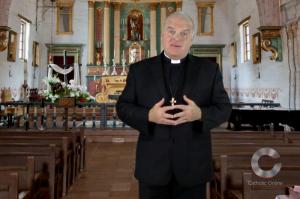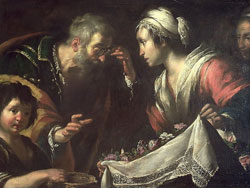We ask you, urgently: don't scroll past this
Dear readers, Catholic Online was de-platformed by Shopify for our pro-life beliefs. They shut down our Catholic Online, Catholic Online School, Prayer Candles, and Catholic Online Learning Resources essential faith tools serving over 1.4 million students and millions of families worldwide. Our founders, now in their 70's, just gave their entire life savings to protect this mission. But fewer than 2% of readers donate. If everyone gave just $5, the cost of a coffee, we could rebuild stronger and keep Catholic education free for all. Stand with us in faith. Thank you.Help Now >
Jacopo Sannazaro
FREE Catholic Classes
(Latin, ACTIUS SINCERUS SANNAZARIUS).
Italian and Latin poet, b. at Naples, 28 July, 1458; d. at Rome, in Aug., 1530. He belonged to a family of Spanish origin, in the service of Charles III, of Durazzo, holding the fief of Rocca di Mondragone from the end of the fourteenth century. He received the name by which he was known because he was born on the feast of St. Nazarius. Having lost his father at an early age, he lived in Nocera dei Pagani with his mother; returning later to Naples he studied with Pontanus and was a member of the academy which assembled about this scholar. In this group he received the name of Sincerus by which he is often mentioned in the letters of the times. He was closely allied with the princes of Aragon at Naples and followed Fedirico into the exile to which he was driven by Louis XII, King of France (1521). Relying on the generosity of the French king, Federico established himself at Tours, and Sannazaro remained with him until his death (9 Sept., 1504). During this time Sannazaro discovered a manuscript containing the hitherto unknown works of Latin poets, the fragment of the "Halieutica" ascribed to Ovid by Pliny the Elder, the "Cynegetica" of Grattius Faliscus, Nemesianus, and Rutilius Namatianis. manuscript 227 of Vienna is actually the portion of this manuscript which contained the "Halieutica" and Grattius. manuscript 3261 of Vienna is only a sixteenth-century copy of Nemesianus and Rutilius. On returmug to his own country Sannazaro left it no more. In his old age he had the sorrow of seeing his villa of Tore di Mergoglino destroyed by the imperial forces. He had just rebuilt it when died.
In his youth Sannazaro wrote a work in mingled verse and prose entitled "Arcadia", in which he described the pastoral life according to the traditions of the ancients. This work had great success; it was translated and imitated, and in the sixteenth century had about sixty editions; the first was at Venice, 12 May, 1502. The "Arcadia" gave rise to the pastoral style of writing much cultivated in Italy and elsewhere. A scholarly edition was issued by Scherillo (Turin, 1888). Sannazaro's other Italian poems were sonnets and canzoni . All were collected by Gallipoli (Padua, 1723). A correspondent of Paulus Manutius mentions another work called "Gliomero", now lost. A work entitled "Farsa" affords an idea of it. It consisted of detached scenes of a popular character, written in the Neapolitan dialect, and intended to amuse the king's Court.
Sannazaro's poetical reputation was formerly founded on his Latin works: the "Ecologiae piscatoriae", bucolic verses concerning fishers, elegies and epigrams containing interesting details concerning the life of the poet and contemporaries, his mistresses, Carmosina, Bonifacia, and Cassandra, and which are the best evidences of his sentiments; "Salices", account of metamorphosis; and especially the "De partu Virginis", a poem in three cantos which cost him twenty years of labor and won him the name of the Christian Virgil. These works show that he was a diligent imitator of Ovid and Virgil. The Christian poem is a mixture of the antique and the modern, of mythology and Biblical reminiscenses. Digressions often far from happy are inserted as ornaments, for instance in connection with the ass of the manger Sannazaro reviews all the legends in which the ass has played a part. He also abuses allegorical personifications. The poem, praised by Leo X before it was known, is dedicated to Clement VII, who covered it with praise. Sannazaro's Latin works were published by Volpi (Padua, 1719) and Janus Bronkhusius (1728).
Join the Movement
When you sign up below, you don't just join an email list - you're joining an entire movement for Free world class Catholic education.

Novena for Pope Francis | FREE PDF Download
-

- Stations of the Cross
- Easter / Lent
- 5 Lenten Prayers
- Ash Wednesday
- Living Lent
- 7 Morning Prayers
- Mysteries of the Rosary
- Litany of the Bl. Virgin Mary
- Popular Saints
- Popular Prayers
- Female Saints
- Saint Feast Days by Month
- Pray the Rosary
JUDGES, GUNS, AND GANGS: Cartels Are Infiltrating America’s Cities and Courtrooms
List of 21 California Missions and Founding Dates
Exploring the California Missions and Their Legacy
Daily Catholic
 Daily Readings for Sunday, April 27, 2025
Daily Readings for Sunday, April 27, 2025 St. Zita: Saint of the Day for Sunday, April 27, 2025
St. Zita: Saint of the Day for Sunday, April 27, 2025 Prayer for the Dead # 2: Prayer of the Day for Sunday, April 27, 2025
Prayer for the Dead # 2: Prayer of the Day for Sunday, April 27, 2025 Daily Readings for Saturday, April 26, 2025
Daily Readings for Saturday, April 26, 2025 St. Cletus: Saint of the Day for Saturday, April 26, 2025
St. Cletus: Saint of the Day for Saturday, April 26, 2025- Prayer before the Closing of the Day: Prayer of the Day for Saturday, April 26, 2025
![]()
Copyright 2025 Catholic Online. All materials contained on this site, whether written, audible or visual are the exclusive property of Catholic Online and are protected under U.S. and International copyright laws, © Copyright 2025 Catholic Online. Any unauthorized use, without prior written consent of Catholic Online is strictly forbidden and prohibited.
Catholic Online is a Project of Your Catholic Voice Foundation, a Not-for-Profit Corporation. Your Catholic Voice Foundation has been granted a recognition of tax exemption under Section 501(c)(3) of the Internal Revenue Code. Federal Tax Identification Number: 81-0596847. Your gift is tax-deductible as allowed by law.


 Daily Readings for Sunday, April 27, 2025
Daily Readings for Sunday, April 27, 2025 St. Zita: Saint of the Day for Sunday, April 27, 2025
St. Zita: Saint of the Day for Sunday, April 27, 2025 Prayer for the Dead # 2: Prayer of the Day for Sunday, April 27, 2025
Prayer for the Dead # 2: Prayer of the Day for Sunday, April 27, 2025 St. Cletus: Saint of the Day for Saturday, April 26, 2025
St. Cletus: Saint of the Day for Saturday, April 26, 2025

